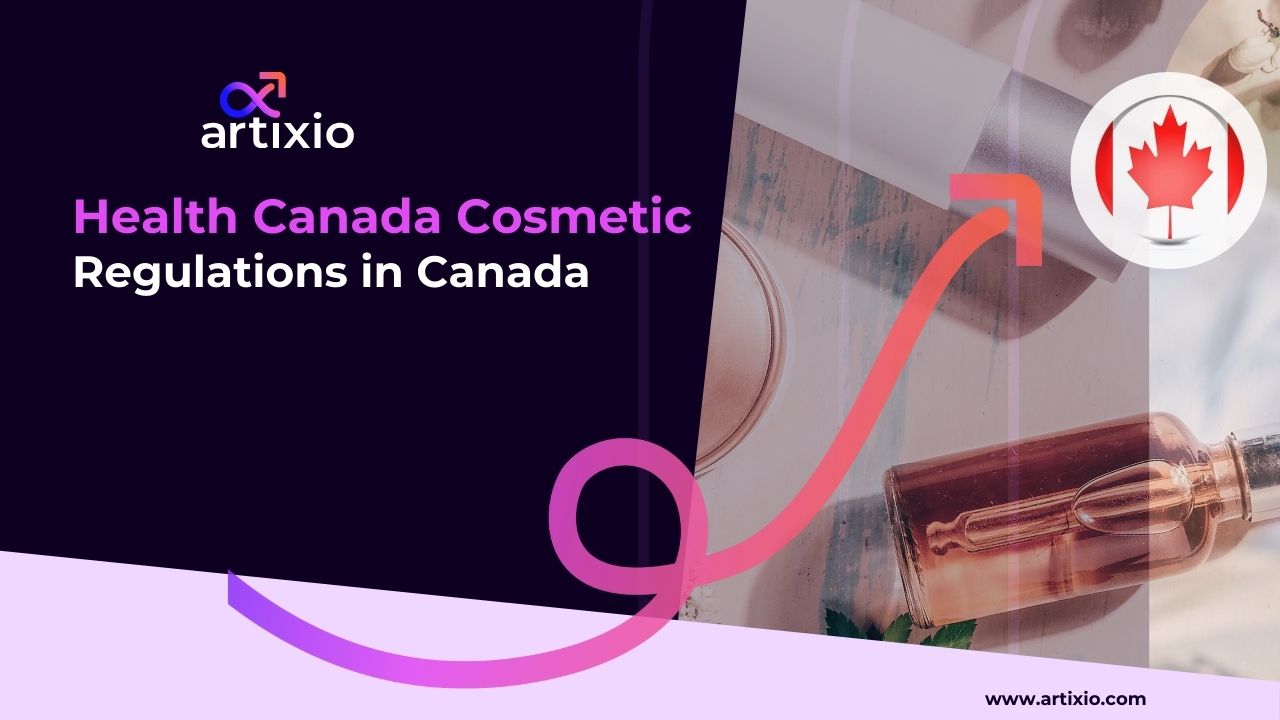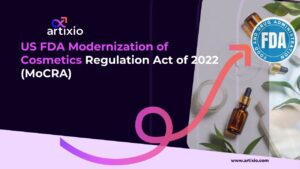Cosmetics play a vital role in our daily routines, but their safety and compliance with regulations are of utmost importance. The cosmetic regulations in Canada is overseen by Health Canada, ensuring that these products are safe for consumer use.
Health Canada Cosmetic Regulations in Canada
Health Canada regulates cosmetics under the Food and Drugs Act (FDA) and the Cosmetic Regulations.
Its primary focus is to ensure the safety, quality, and proper labeling of cosmetic products sold in the Canadian market. Requirements under other legislation, such as the Consumer Packaging and Labelling Act (CPLA), the Canadian Environmental Protection Act, 1999 (CEPA) and the Cannabis Act, must also be met, if applicable.
Under the Food and Drugs Act, a cosmetic includes “any substance or mixture of substances, manufactured, sold or represented for use in cleansing, improving or altering the complexion, skin, hair or teeth and includes deodorants and perfumes.” This includes:
- Cosmetics used by professional aesthetic services
- Bulk institutional products such as hand soap in school rest rooms
- “handmade” cosmetics sold through home-based businesses or craft sales
The Cosmetic Regulations in Canada and the Food and Drugs Act require that cosmetics sold in Canada are manufactured, prepared, preserved, packed and stored under sanitary conditions. The manufacturer and importer must submit a Health Canada Cosmetic Notification Form (CNF) to Health Canada before selling their cosmetic products in Canada.
This form includes detailed information about the product, its ingredients, area of application, and manufacturer details. The Cosmetic manufacturers also need to provide a list of ingredients and their concentrations in the CNF. Health Canada checks these ingredients against the Hotlist to ensure they comply with regulations.
Cosmetic Ingredient
A cosmetic ingredient is any substance or component that is added to the formulation on purpose and remains in the final product. Ingredients usually have a function and give a certain physical property to the final product.
Example: conditioning agents, fragrances, colouring agents, preservatives and flavours.
Impurities or substances consumed during the manufacturing process are not considered cosmetic ingredients and do not need to be included on the notification form. The cosmetic manufacturers must refer to the List of ingredients that are prohibited and / or restricted for use in cosmetics products.
Notification of cosmetics in Canada
The Health Canada Cosmetic Notification form (CNF) is applicable to various entities involved in the cosmetics industry, including cosmetic manufacturers, Canadian importers, and notifiers acting on behalf of manufacturers or importers.
Each distinct product necessitates a separate submission of a Cosmetic Notification Form unless specific criteria are met:
- If a CNF has been previously submitted for an identical product but in a different container size.
- When submitting a CNF that encompasses multiple products, provided it fulfills the criteria for a unified notification of multiple products.
A consolidated notification for several products is permissible under certain conditions:
- All individual products listed in the CNF must share the same core product name or trademark.
- The product base remains consistent in composition across all items, with minor alterations permitted only for coloring, fragrance, or flavoring.
- Uniformity in information within the CNF, excluding composition, must be sustained across the product line, covering elements like form, function, manufacturer, and distributor.
Modest changes in the product line, such as the addition or removal of a few items, do not mandate an amendment to the CNF.
Health Canada Cosmetic Notification Form
Three main types of notifications exist – New, Amendment, and Discontinue Sale. These categories help in informing Health Canada about new products, changes in information, or discontinuation of products within specific time frames.

The notifier must include the Cosmetic Number while submitting the Amendment and discontinued sale type of notification forms.
Product Details
The Cosmetic Notification Form (CNF) requires specific details such as the Product Notifier’s reference, the primary brand and name of the product, the anticipated or actual date of the first sale in Canada, and any additional names or translations associated with the product. In case of multiple products sharing the same base formulation but differing in shade, color, scent, fragrance, or flavor, they should be listed together in this section.
Moreover, the product description section allows for a description of the product’s intended purpose. It also permits identification of cosmetic products that are bundled together, such as in a gift basket or combo pack. Notably, such packaged products should be treated separately in the notification, not as kits. It is essential to specify the products contained in the package and their respective cosmetic numbers.
Applicants are required to accurately select the appropriate Area of application, Form of product, and Function of product. The form of the cosmetic refers to its final packaged state, ready for sale to consumers.
Notifier Information
The details required for the contact person or entity submitting the CNF include the following: the individual or company acting as the notifier, which could be the manufacturer, a Canadian importer, or their designated representative. All official communications will be directed to this notifier. As such, please provide the complete legal business name, a detailed mailing address, and comprehensive contact information, encompassing the telephone number and email address, of the entity responsible for submitting the CNF.
Manufacturing and Distribution Information
The Cosmetic Notification Form (CNF) necessitates the inclusion of contact information for manufacturers and distributors, reflecting the details as presented on the product label. If the entity mentioned on the label is not the actual manufacturer or formulator of the cosmetic product, additional manufacturer contact information should be provided.
At least one manufacturer or importer located in Canada must be specified in this section. Additionally, Canadian distributors can also be listed here. To simplify the process, there is an option to check the “Same as Notifier” box if the notifier acts as the manufacturer or importer.
Moreover, the form mandates the selection of a “Contact Type” for the provided information, requiring clarification if the contact is a distributor, importer, or manufacturer. In cases where a contact performs multiple roles, the highest position in the product’s distribution chain should be chosen. For instance, if the contact functions as both an importer and distributor, the role of importer should be selected.
Product Ingredients
The Cosmetic Notification Form (CNF) requires detailed information about product ingredients and their concentrations, ensuring accurate compliance with the product label. To streamline processing and prevent delays, the CNF guidelines emphasize specific criteria:
Ingredient Listing: Each product ingredient and its concentration must be entered separately on the CNF. For proprietary blends, individual components should be listed separately. Usage of International Nomenclature for Cosmetic Ingredient (INCI) names is encouraged. Various naming systems can be used if INCI names are unavailable.
Ingredient Validation: After entering an ingredient, the “Search Ingredient” button validates it, displaying relevant information about its status in Canadian cosmetics. Statuses include “Known,” “Restricted,” “Prohibited,” or “Unknown/Not Found.” The Hotlist should be consulted for each CNF submission for ingredient acceptability.
Concentration Details: Concentration information can be provided in exact values or concentration ranges. The total concentration should typically sum up to 100%. For products with variable ingredients, such as those marked “May contain,” these variations should be indicated.
Additional Information: For aerosol products, propellant ingredients and their concentrations must be listed on the CNF and product label. Incidental ingredients don’t require listing, while fragrance and flavouring agents can be grouped under respective categories.
Health Canada Queries: Health Canada may reach out for further information, such as safety demonstration, label provision, reformulation, or product recall, if concerns arise regarding the CNF, product, or compliance issues.
The CNF shall include precise ingredient information, ensuring alignment with product labels and regulatory compliance, while providing avenues for additional clarifications and corrections, if necessary, by Health Canada.
Additional documents and pictures
When a cosmetic product poses an avoidable hazard outlined in the Cosmetic Regulations in Canada or Cosmetic Ingredient Hotlist, including ingredients requiring safety warning statements, the notifier must submit copies of labels and inserts alongside the CNF. Failure to provide these documents initially may prompt a request from Health Canada to furnish the necessary labels or other relevant documents.
Health Canada may request additional information or impose restrictions if any ingredient raises concerns about safety. This process ensures that products meet safety standards before they reach consumers. After a product is launched in the market, Health Canada continues monitoring it for any adverse reactions or safety concerns. Manufacturers should promptly report any adverse events associated with their products.
The regulations enforced by Health Canada are pivotal in safeguarding consumers from potentially harmful cosmetics. Adherence to these regulations is crucial for manufacturers to ensure the safety, quality, and compliance of their cosmetic products. As a manufacturer or importer, ensuring compliance with Health Canada’s regulations not only upholds safety standards but also builds trust between manufacturers and consumers. Cosmetic safety remains a paramount concern, and adherence to regulations is a shared responsibility for the benefit of all stakeholders.
At Artixio, we specialize in regulatory compliance solutions. For guidance on navigating Health Canada’s cosmetic regulations or assistance in submitting your Cosmetic Notification Forms, reach out to us today. Contact Artixio for Compliance Assistance.





